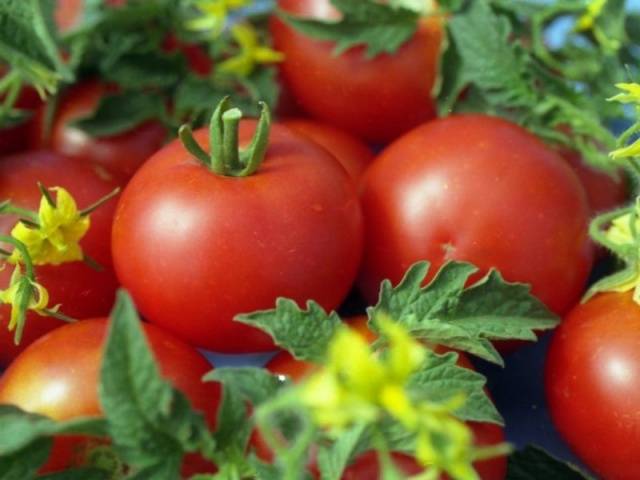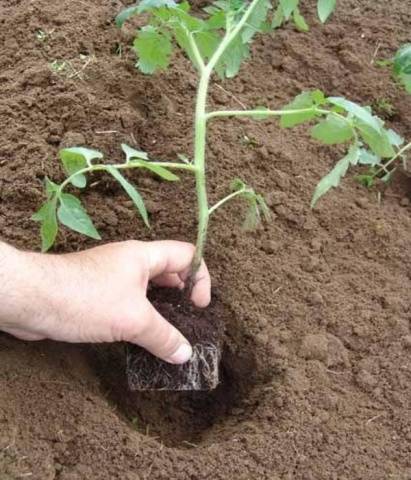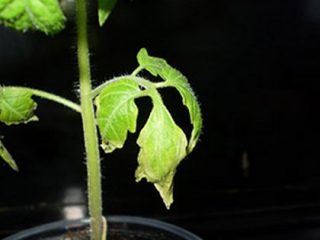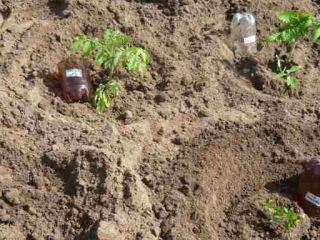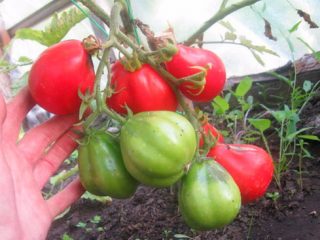Content
It is difficult to argue about the taste of tomatoes - each consumer has his own preferences. However, Gin's tomato leaves no one indifferent.
Description of the variety
Gin's tomato is a determinant one (they have limited growth and a certain number of ovaries), undersized bushes grow on average 55-60 cm in height. The bush usually contains three to four stems that do not require garter, pinching or shaping. On one brush 3-6 Gin tomatoes ripen, and the first brush is usually laid above the eighth leaf, and the next ones - after one or a couple of leaves.
Gin's tomatoes have a rounded, slightly ribbed shape, a little "pressed" near the stalk (as in the photo).
Fruits of a rich red color are distinguished by a mass of 200-300 g, a sweetish taste with hints of light sourness. Ripe Gin tomatoes have a thick, dense skin and a fleshy, juicy flesh. Thanks to their tough skin, tomatoes are well stored and perfectly transported.
Gin's tomato can be considered versatile, since the fruits are very tasty both fresh and canned. You can visually appreciate the merits of Gin's tomatoes in the photo.
The Gina TST variety is a hybrid and belongs to the mid-season varieties. The crop appears in 97-105 days after planting. Tomatoes weighing about 200 g are characterized by a round shape, juicy tasty pulp. Gina TST is planted in the open field or in a greenhouse. A bush 53-65 cm high is formed by two or three trunks growing immediately from the root.
A feature of the Gina TST variety is that the bush grows branched, so they do not plant more often than four tomatoes per square meter on the site. Manufacturers insist that there is no need to tie up the plant. However, according to the reviews of summer residents, it is advisable to fix the tomato near the support, otherwise the plant may fall apart. Delicious fruits ripen with a weight of 220-360 g, therefore tomatoes, due to their size, are used only fresh, and not for winter harvesting.
Planting and leaving
Gardeners consider Gin's tomato one of the best tomato varieties because it is easy to grow and does not require special conditions to get a good harvest.
Growing and planting seedlings
The tomato bears fruit well outdoors and indoors.
In order not to be mistaken with the timing, when growing a Gin tomato, it is advisable to build on the location of the site. In different climatic conditions, the ripening period for Gina ranges from 85-120 days.
Both non-seedling and seedling methods can be used to grow Gina.
- With the seedless method, tomato seeds are sown directly into the ground. A similar method is best used in the southern regions. Sowing is advisable to carry out in a well-lit area of the soil. On the eve of planting, the seeds are soaked for 8-10 hours to accelerate the emergence of seedlings. Place 3-4 Gin tomato seeds in each hole. The distance in the row between the holes is 25-30 cm, and the row spacing is 65-70 cm. To accelerate the germination of seeds, sometimes the bed is covered with a film. After the emergence of seedlings, it is recommended to thin out the tomatoes - the strongest tomato seedling Gina is left in the hole, and the rest are removed.
- With the seedling method, seedlings are first grown. For this, tomato seeds are sown in a box at the end of March.Since the Gina variety is sensitive to low temperatures, seedlings can be planted in open ground after the threat of frost has passed. The best option is early June, when the ground warms up well. It is recommended to plant 3-4 tomatoes per square meter. Until the seedlings get stronger, you can tie them to a support.
In warm regions, it is undesirable to tie up Gin's tomatoes. Bushes lying on the ground will prevent the soil from drying out and protect the roots of the plant.
Fertilization
When planting seedlings in open ground, it is recommended to sprinkle the bottom of the hole with wood ash, which will be a source of the necessary trace elements. It will also prevent Gin's tomatoes from protecting against certain diseases.
With the seedless method, feeding is carried out after thinning the seedlings: 15 g of ammonium nitrate are diluted in 10 liters of water. There is a liter of solution per hole. When planting tomato seedlings, fertilizer is applied after 10-14 days. For the following dressings, complex mineral fertilizers are used. If there are no inorganic compounds, you can use organic matter: a liter of manure is diluted in 10 liters of water and insisted for 9-12 days. After that, a liter of manure infusion is diluted in 10 liters of water. A liter of solution is poured under each Gin's tomato bush.
To obtain a bountiful harvest of Gina's tomato, it is recommended to alternately apply root fertilizers and foliar fertilizers. As soon as the ovaries appear, fertilizers are applied exclusively at the root.
Watering a tomato
Irrigation of Gina tomatoes has its own characteristics:
- increased moisture leads to a decrease in the sugar content of the fruit and the appearance of a watery structure. The risk of fungal diseases increases;
- prolonged drought can provoke the fall of tomato ovaries, damage to plants with apical rot.
Therefore, infrequent, but abundant watering can be considered the golden mean. The best option: once or twice a week. When choosing an irrigation regime, it is important to take into account the climatic features of the region. Avoid getting moisture on stems, leaves and fruits. On hot sunny days, it is advisable to set aside the evening time for watering Gin's tomato, and in cloudy weather, the watering time does not really matter.
General care for Gina is simple: weed the soil, loosen the soil after watering. When loosening the bushes, care must be taken not to damage the tomato root system. The tomato does not need a mandatory garter. Rather, it will be a whim of the gardener. It is recommended to hilling the plant.
There is no need to pinch tomatoes either. The bush is usually formed from 3-4 stems. Moreover, it is recommended to carefully cut off the lower leaves in order to increase the ventilation of the plants. Cut the leaves carefully so as not to damage the skin of the trunk.
Gin's tomato is a very productive variety. With proper care, each bush yields 3-4 kg of excellent mouth-watering tomatoes.
Diseases and pests
The Gina variety is resistant to many diseases. The greatest damage to tomatoes is caused by pests - aphids, Colorado potato beetle, bear:
- aphid - a harmful insect that feeds on plant sap, which leads to a halt in the growth and flowering of tomatoes, new fruits are not set. A dangerous feature of aphids is to carry viral and fungal diseases. External manifestation of the lesion - tomato leaves turn yellow, curl. For chemical treatment, the preparations "Biotlin", "Askarin", "Iskra" are used. Preventive measures include: burning plant residues, digging land for the winter, spring spraying the plot for tomatoes with karbofos. Before spraying the bushes with chemicals, they must first pluck all the tomatoes - ripe and starting to blush.
- Colorado beetle... Insect larvae are capable of destroying an adult tomato bush in 18-20 days - they eat up the foliage. One-time measures are indispensable for pest control. Means of struggle: collecting beetles, constant loosening of the soil, digging it up for the winter, regular use of chemicals ("Mospilan", "Prestige"). Folk methods - planting along the beds and along the perimeter of the site of calendula, nasturtium, garlic;
- bear lives in the topsoil and destroys Gina's root system, which leads to disease or even death of the plant. It is not difficult to detect the presence of a pest - the bush withers, the foliage turns yellow and falls off. The optimal means of struggle is the use of drugs Zemlin, Medvetox. The granules are placed in a furrow dug along the perimeter of the tomato plot. The poison is buried and watered abundantly.
To maximize the protection of Gin's tomato from pests, it is recommended to carry out comprehensive plant protection - use chemical and folk remedies, dig up the soil in autumn, burn the remains of tomato bushes.
Gina's tomato is a great variety. Even a novice summer resident will be able to harvest a good tomato harvest if he follows the rules for caring for the plant.
